Karl Struss: Nov 30, 1886-Dec 16, 1981
Stereo Pictorialist
By Ray
Zone
One of the most noteworthy members the Stereo Division of the Photographic
Society of America (PSA) and the Stereo Club of Southern California (SCSC) has
ever had is Karl Struss.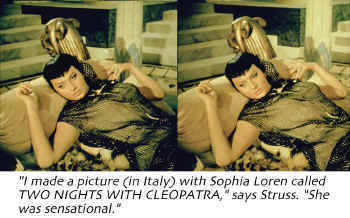 Most famous as the first cameraman (along with Charles
Rosher) to win an Academy Award for Best Cinematography for the 1927 film
Sunrise, directed by F.W. Murnau, Struss's entire life was dedicated to the
craft of photography. "Struss was by temperament a pictorialist, by instinct an
illusionist and by accomplishment one of the great cameramen in the floridly
creative quarter century of filmmaking that followed The Birth of a Nation
(1915)," writes Scott Eyman in Five American Cinematographers (Scarecrow Press:
1987).
Most famous as the first cameraman (along with Charles
Rosher) to win an Academy Award for Best Cinematography for the 1927 film
Sunrise, directed by F.W. Murnau, Struss's entire life was dedicated to the
craft of photography. "Struss was by temperament a pictorialist, by instinct an
illusionist and by accomplishment one of the great cameramen in the floridly
creative quarter century of filmmaking that followed The Birth of a Nation
(1915)," writes Scott Eyman in Five American Cinematographers (Scarecrow Press:
1987).
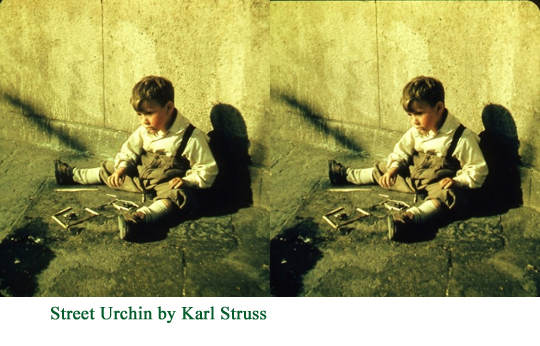 Born in New York in 1886, Struss studied photography with Clarence H.
White and was admitted to Alfred Stieglitz's "291" photo-pictorialist group in
1909. By 1914, Struss was an accomplished pictorial photographer with his own
studio who was selling work to Vogue, Vanity Fair and Harper's Bazaar magazines.
"It wasn't fashion photography," said Struss, "it was pictorial
photography."
Born in New York in 1886, Struss studied photography with Clarence H.
White and was admitted to Alfred Stieglitz's "291" photo-pictorialist group in
1909. By 1914, Struss was an accomplished pictorial photographer with his own
studio who was selling work to Vogue, Vanity Fair and Harper's Bazaar magazines.
"It wasn't fashion photography," said Struss, "it was pictorial
photography."
Migrating as a still photographer to Hollywood in 1919, Struss signed on
with Cecil B. DeMille as a second unit cameraman. Soon, he was filming Ben Hur
(1925) with the early two-color Technicolor process and working with stars like
Mary Pickford on Sparrows (1926) and Fredric March on Dr. Jekyll and Mr. Hyde
(1932). Struss produced masterful pictorialist photography with dissolves, soft
lighting effects and double exposures on Sunrise (1927) and was at the top of
his craft when Mary Pickford insisted he photograph her first sound film,
Coquette, in 1928.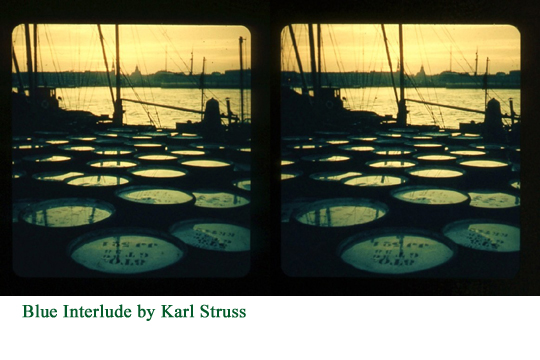
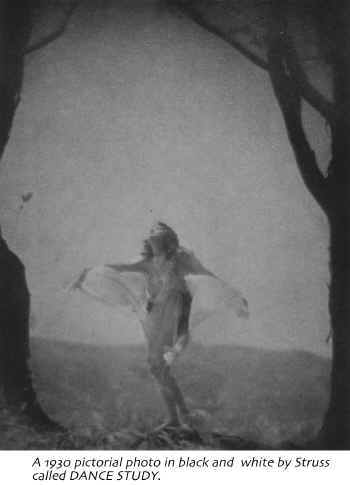
Invited to join the American Society of Cinematographers and bear the
distinguished letters "ASC" after his name in motion picture
credits, Struss was equally at home with black-and-white or color
cinematography. "Cinematography in present-day dramatic films is not an end, but
a means to an end, whereas the still picture is often, if not always, both the
means and the end itself," wrote Struss in a 1934 issue of American
Cinematographer with an article titled "Photographic Modernism and the
Cinematographer." From 1920 to 1959, Struss was the cinematographer on over 135
feature films. Notable collaborations for Struss included work with D.W.
Griffith on Abraham Lincoln (1930) and Charlie Chaplin on The Great Dictator
(1940) and Limelight (1952).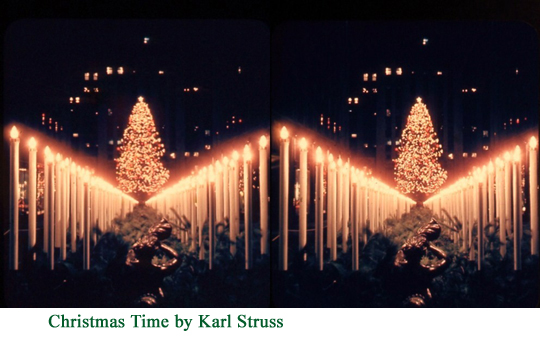
When the Stereo-Realist Camera came on the market in 1947, Struss was an
early enthusiast and he became one of the first members of the Stereo Division
of the PSA when it was formed in 1952. Struss was also a charter member of the
PSA Stereo Club of Southern California in 1956 at which time he served on the
Program Committee. The veteran stereo photographer was active in many PSA, SCSC,
S4C and other international stereo slide competitions until 1965.
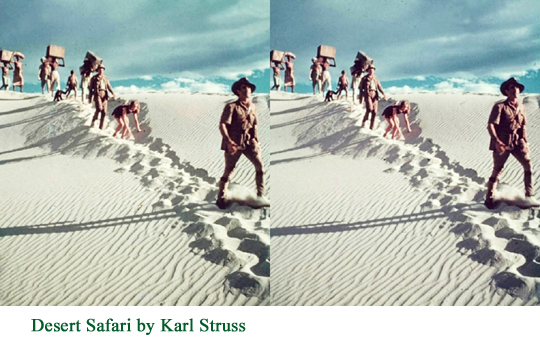 Struss garnered many acceptances for his stereo slides in the PSA
Hollywood International Salon and numerous Honorable Mentions (HM) in PSA
International Exhibitions. In the 1965 Rochester International Stereo Salon,
Struss garnered acceptances, for "Anthony and Cleopatra" and "Distant Bellagio"
and an HM for "Varenna Moonlight." Struss had photographed these images with his
Stereo-Realist camera while working on location in Italy in 1953 and 1954 as a
director of photography on four feature films, three of which were in 3-D.
Struss garnered many acceptances for his stereo slides in the PSA
Hollywood International Salon and numerous Honorable Mentions (HM) in PSA
International Exhibitions. In the 1965 Rochester International Stereo Salon,
Struss garnered acceptances, for "Anthony and Cleopatra" and "Distant Bellagio"
and an HM for "Varenna Moonlight." Struss had photographed these images with his
Stereo-Realist camera while working on location in Italy in 1953 and 1954 as a
director of photography on four feature films, three of which were in 3-D.
"I enjoyed working in Italy," said Struss. "the directors and I got along
and I loved Rome and the people." Struss worked in Italy as a stereoscopic
cinematographer on The Funniest Show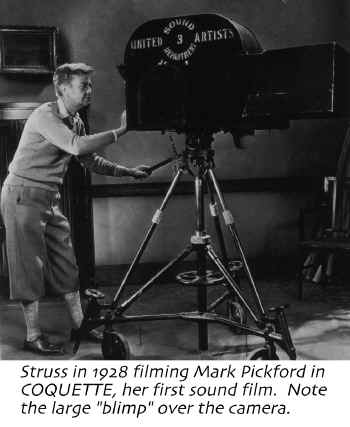 on Earth (Il Piu Comico Spettacolo Del
Mondo) and The Neapolitan Turk (Il Turco Napoletano), both directed by Mario
Mattoli in 1953 in color and filmed with a dual 35mm system. Rustic Cavalry
(Cavalleria Rusticana), was a black-and-white 3-D film starring Anthony Quinn
and May Britt.. Sophia Loren had originally been cast in Rustic Cavalry but was
replaced by Kerima shortly after filming began.
on Earth (Il Piu Comico Spettacolo Del
Mondo) and The Neapolitan Turk (Il Turco Napoletano), both directed by Mario
Mattoli in 1953 in color and filmed with a dual 35mm system. Rustic Cavalry
(Cavalleria Rusticana), was a black-and-white 3-D film starring Anthony Quinn
and May Britt.. Sophia Loren had originally been cast in Rustic Cavalry but was
replaced by Kerima shortly after filming began.
"I made a [2-D] picture with Sophia Loren called Two Nights With
Cleopatra, (Due Notte Con Cleopatra)" said Struss. "Oh, the sets were beautiful,
gorgeous, and she was sensational. But when they dubbed it into this flat
English, all the atmosphere went out of it." Struss' stereo slide of "Anthony
and Cleopatra" from the Rochester International Salon featured Sophia Loren in a
behind-the-scenes shot that Struss had made while filming her in Italy.
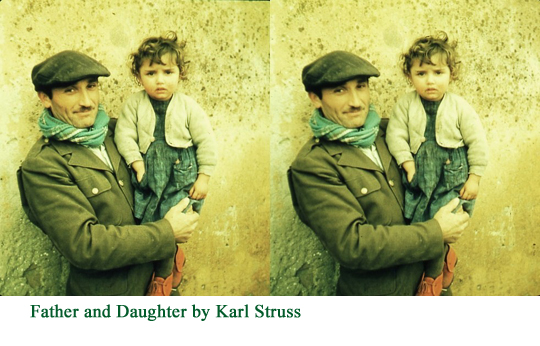 Of the three 3-D films Struss photographed in Italy, only Rustic Cavalry was
released in the United States, but in 2-D. Before leaving for Italy in 1953,
Struss had photographed for producer Sol Lesser in Hollywood with "Stereo Cine,"
a dual 35mm system, the first segment of a film called The 3-D Follies. R.M.
Hayes in 3-D Movies (McFarland: 1989) calls this film "one of the great
mysteries of 3-D history." 3-D Follies was apparently filmed at the RKO Studios
in Eastman Color and featured an array of performers that included Milton Berle
and Lili St. Cyr.
Of the three 3-D films Struss photographed in Italy, only Rustic Cavalry was
released in the United States, but in 2-D. Before leaving for Italy in 1953,
Struss had photographed for producer Sol Lesser in Hollywood with "Stereo Cine,"
a dual 35mm system, the first segment of a film called The 3-D Follies. R.M.
Hayes in 3-D Movies (McFarland: 1989) calls this film "one of the great
mysteries of 3-D history." 3-D Follies was apparently filmed at the RKO Studios
in Eastman Color and featured an array of performers that included Milton Berle
and Lili St. Cyr.
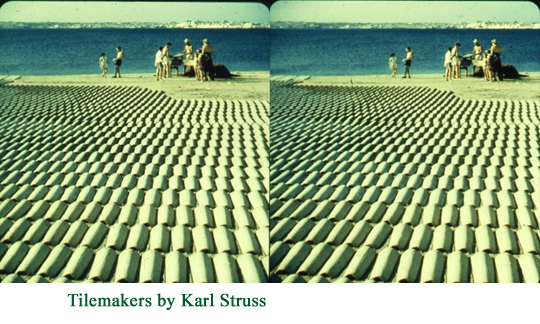
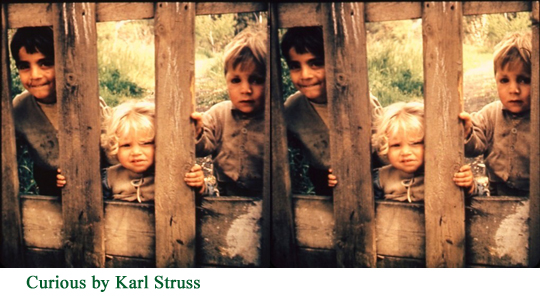
There are several important questions that historians of
Struss' work and stereoscopic cinema will ask. Was The 3-D Follies actually
completed and released? Do the stereoscopic elements for Struss' three Italian
feature films in 3-D still survive? And, most importantly, where are these films
today?
"I never got bored," said Karl Struss. "Never wanted to photograph
something differently after I'd done it." Struss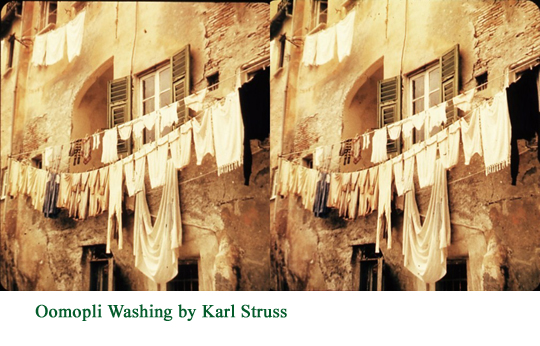 passed away on December 16,
1981. "Photography was the ne plus ultra of Struss' life," writes Scott Eyman.
"Whether it was the pictorial stills in which he began, cinematography, or the
3-D photography that was consuming him towards the end of his life, the
challenge for Struss was always to express a mood, to tell a story through his
camera, to find in nature what expressed the emotions of man."
passed away on December 16,
1981. "Photography was the ne plus ultra of Struss' life," writes Scott Eyman.
"Whether it was the pictorial stills in which he began, cinematography, or the
3-D photography that was consuming him towards the end of his life, the
challenge for Struss was always to express a mood, to tell a story through his
camera, to find in nature what expressed the emotions of man."
 Most famous as the first cameraman (along with Charles
Rosher) to win an Academy Award for Best Cinematography for the 1927 film
Sunrise, directed by F.W. Murnau, Struss's entire life was dedicated to the
craft of photography. "Struss was by temperament a pictorialist, by instinct an
illusionist and by accomplishment one of the great cameramen in the floridly
creative quarter century of filmmaking that followed The Birth of a Nation
(1915)," writes Scott Eyman in Five American Cinematographers (Scarecrow Press:
1987).
Most famous as the first cameraman (along with Charles
Rosher) to win an Academy Award for Best Cinematography for the 1927 film
Sunrise, directed by F.W. Murnau, Struss's entire life was dedicated to the
craft of photography. "Struss was by temperament a pictorialist, by instinct an
illusionist and by accomplishment one of the great cameramen in the floridly
creative quarter century of filmmaking that followed The Birth of a Nation
(1915)," writes Scott Eyman in Five American Cinematographers (Scarecrow Press:
1987). Born in New York in 1886, Struss studied photography with Clarence H.
White and was admitted to Alfred Stieglitz's "291" photo-pictorialist group in
1909. By 1914, Struss was an accomplished pictorial photographer with his own
studio who was selling work to Vogue, Vanity Fair and Harper's Bazaar magazines.
"It wasn't fashion photography," said Struss, "it was pictorial
photography."
Born in New York in 1886, Struss studied photography with Clarence H.
White and was admitted to Alfred Stieglitz's "291" photo-pictorialist group in
1909. By 1914, Struss was an accomplished pictorial photographer with his own
studio who was selling work to Vogue, Vanity Fair and Harper's Bazaar magazines.
"It wasn't fashion photography," said Struss, "it was pictorial
photography."


 Struss garnered many acceptances for his stereo slides in the PSA
Hollywood International Salon and numerous Honorable Mentions (HM) in PSA
International Exhibitions. In the 1965 Rochester International Stereo Salon,
Struss garnered acceptances, for "Anthony and Cleopatra" and "Distant Bellagio"
and an HM for "Varenna Moonlight." Struss had photographed these images with his
Stereo-Realist camera while working on location in Italy in 1953 and 1954 as a
director of photography on four feature films, three of which were in 3-D.
Struss garnered many acceptances for his stereo slides in the PSA
Hollywood International Salon and numerous Honorable Mentions (HM) in PSA
International Exhibitions. In the 1965 Rochester International Stereo Salon,
Struss garnered acceptances, for "Anthony and Cleopatra" and "Distant Bellagio"
and an HM for "Varenna Moonlight." Struss had photographed these images with his
Stereo-Realist camera while working on location in Italy in 1953 and 1954 as a
director of photography on four feature films, three of which were in 3-D. on Earth (Il Piu Comico Spettacolo Del
Mondo) and The Neapolitan Turk (Il Turco Napoletano), both directed by Mario
Mattoli in 1953 in color and filmed with a dual 35mm system. Rustic Cavalry
(Cavalleria Rusticana), was a black-and-white 3-D film starring Anthony Quinn
and May Britt.. Sophia Loren had originally been cast in Rustic Cavalry but was
replaced by Kerima shortly after filming began.
on Earth (Il Piu Comico Spettacolo Del
Mondo) and The Neapolitan Turk (Il Turco Napoletano), both directed by Mario
Mattoli in 1953 in color and filmed with a dual 35mm system. Rustic Cavalry
(Cavalleria Rusticana), was a black-and-white 3-D film starring Anthony Quinn
and May Britt.. Sophia Loren had originally been cast in Rustic Cavalry but was
replaced by Kerima shortly after filming began. Of the three 3-D films Struss photographed in Italy, only Rustic Cavalry was
released in the United States, but in 2-D. Before leaving for Italy in 1953,
Struss had photographed for producer Sol Lesser in Hollywood with "Stereo Cine,"
a dual 35mm system, the first segment of a film called The 3-D Follies. R.M.
Hayes in 3-D Movies (McFarland: 1989) calls this film "one of the great
mysteries of 3-D history." 3-D Follies was apparently filmed at the RKO Studios
in Eastman Color and featured an array of performers that included Milton Berle
and Lili St. Cyr.
Of the three 3-D films Struss photographed in Italy, only Rustic Cavalry was
released in the United States, but in 2-D. Before leaving for Italy in 1953,
Struss had photographed for producer Sol Lesser in Hollywood with "Stereo Cine,"
a dual 35mm system, the first segment of a film called The 3-D Follies. R.M.
Hayes in 3-D Movies (McFarland: 1989) calls this film "one of the great
mysteries of 3-D history." 3-D Follies was apparently filmed at the RKO Studios
in Eastman Color and featured an array of performers that included Milton Berle
and Lili St. Cyr.

 passed away on December 16,
1981. "Photography was the ne plus ultra of Struss' life," writes Scott Eyman.
"Whether it was the pictorial stills in which he began, cinematography, or the
3-D photography that was consuming him towards the end of his life, the
challenge for Struss was always to express a mood, to tell a story through his
camera, to find in nature what expressed the emotions of man."
passed away on December 16,
1981. "Photography was the ne plus ultra of Struss' life," writes Scott Eyman.
"Whether it was the pictorial stills in which he began, cinematography, or the
3-D photography that was consuming him towards the end of his life, the
challenge for Struss was always to express a mood, to tell a story through his
camera, to find in nature what expressed the emotions of man."